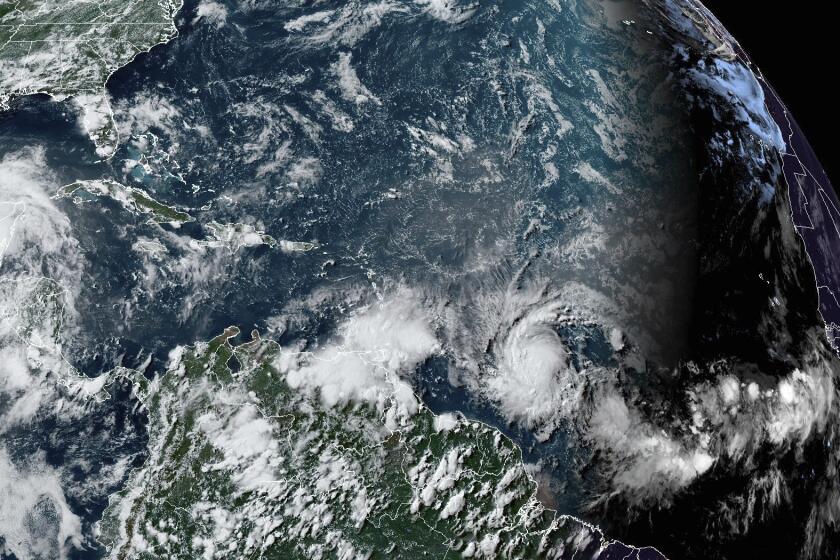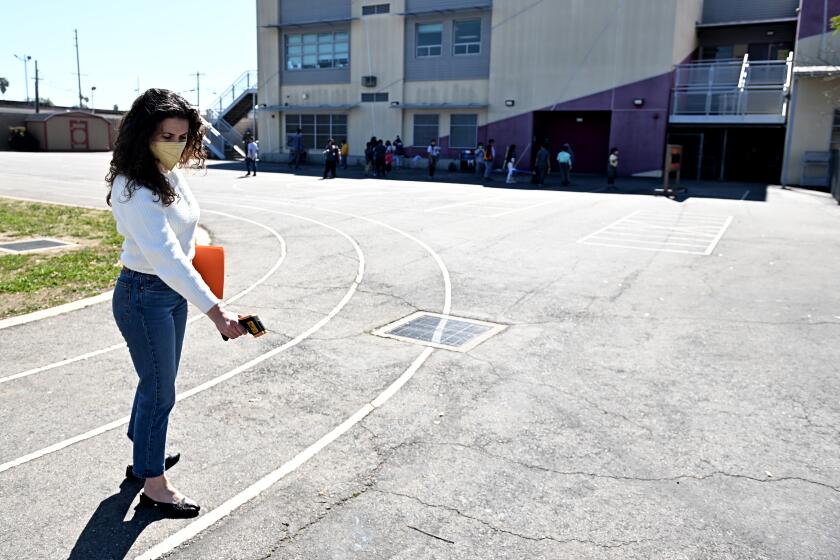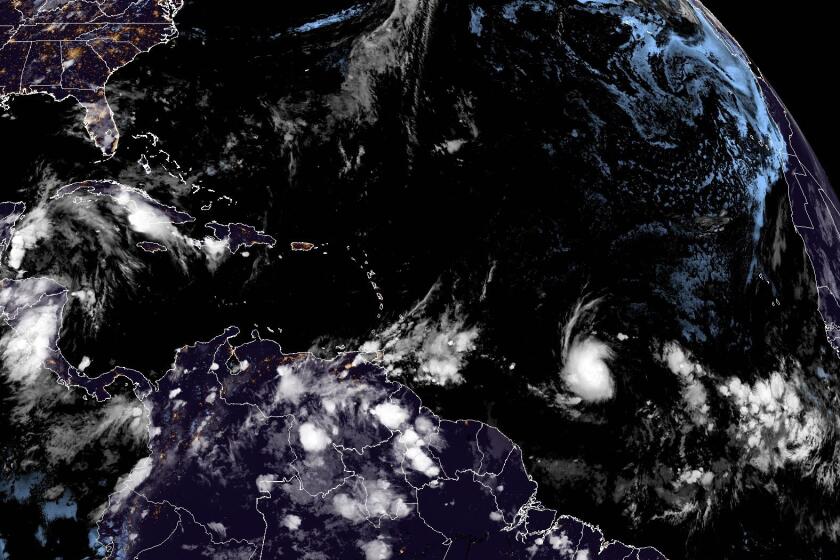These farmers dominate the Colorado River. Cross them at your peril

This story originally published in Boiling Point, a weekly newsletter about climate change and the environment. Sign up here to get it in your inbox.
The letter from Arizona Sen. Mark Kelly was greeted like an act of war in California’s Imperial Valley.
Writing in October, the astronaut-turned-politician urged the Biden administration to withhold funding for the dying Salton Sea until California committed to using less Colorado River water. Never mind that allowing the desert lake to keep drying up would result in hazardous dust pollution choking the Imperial Valley’s low-income, largely Latinx population.
Betty Miller, editor in chief of Imperial news publication the Desert Review, wrote that Kelly “is willing to subject those living around the Salton Sea, people, birds, fish, and more to a spiral of declining health so he can look like a hero to his constituents.”
“He shows a careless disregard for life,” Miller wrote.

Unlike most Californians, I’ve spent a lot of time in Imperial, reporting dozens of stories there over the last decade. It’s a beautiful and at times unspeakably sad place. The poverty is as wrenching as the verdant farm fields are gorgeous at sunset. The amount of water consumed by those farms is mind-boggling. The irrigation district has been plagued by allegations of corruption.
And the potential to help solve the climate crisis is enormous.
That’s the focus of my latest story in The Times’ Repowering the West series. I wrote about the huge opportunity to save water and generate clean power by building solar projects in Imperial — and why some farmers are fighting back.
Here’s the story, with photos by Robert Gauthier and video by Jessica Q. Chen, Maggie Beidelman and Jackeline Luna.
For now, the piece is available exclusively to L.A. Times subscribers. I’d encourage you to consider supporting our journalism with a digital subscription, if you don’t have one already. We’re able to tell these important stories only with your help.

What happens in Imperial matters to everyone else in part because of the valley’s startlingly large draw on the Colorado River, which supplies 40 million people across seven states. Solar projects could be a key strategy for retiring some farmland and leaving more water in Lake Mead. Or not, if local landowners who oppose solar succeed in derailing development.
It’s just one example of a conflict between renewable energy and agriculture playing out across the American West.
Faced with growing opposition to solar and wind development on public lands — which can destroy sensitive wildlife habitat — energy companies are increasingly turning to farming communities. But in many Western states — from Washington’s Columbia Basin to Colorado’s Eastern Plains — you’ll find farmers campaigning against solar and wind, just as they are in Imperial.
Their concerns are place-specific, but they carry some common themes: Industrial energy projects are changing the look and feel of the places we know and love, and reshaping our economies against our will.
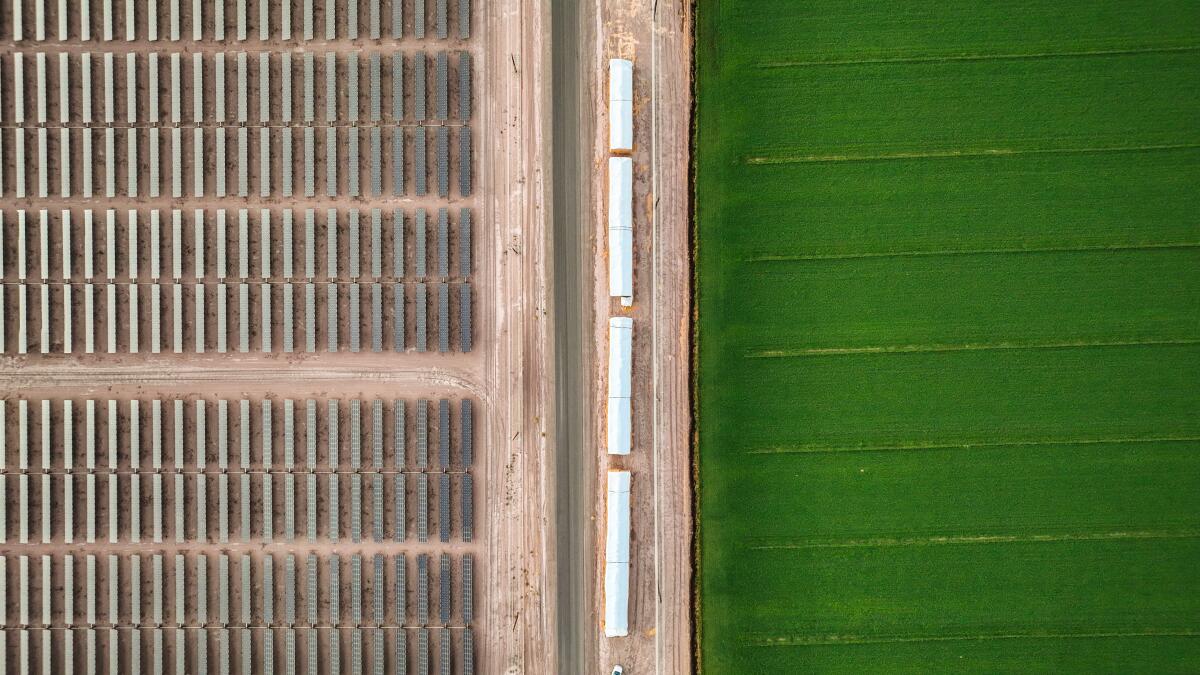
California’s San Joaquin Valley is another hotbed for this debate. A recent report from the Public Policy Institute of California noted that growers there could be forced to take as many as 1 million acres out of production over the next two decades to comply with new rules against overpumping groundwater. Solar farms are one way to soften the blow, the report argues.
J.B. Hamby, an elected board member at the Imperial Irrigation District, offered a fascinating explanation for local opposition to solar projects. As we drove toward the Salton Sea — early morning sunlight lighting our path — he told me “there are individual property rights that we all love and respect, but there are also collective community values that I think are forgotten.”
“This entire area is a collective project. And when you have solar installations come in here, you chip away at that, and we have less of this thing we’ve built,” Hamby said.
The tricky part is, this thing they’ve built is increasingly unsustainable — and increasingly crucial to the Golden State’s future.
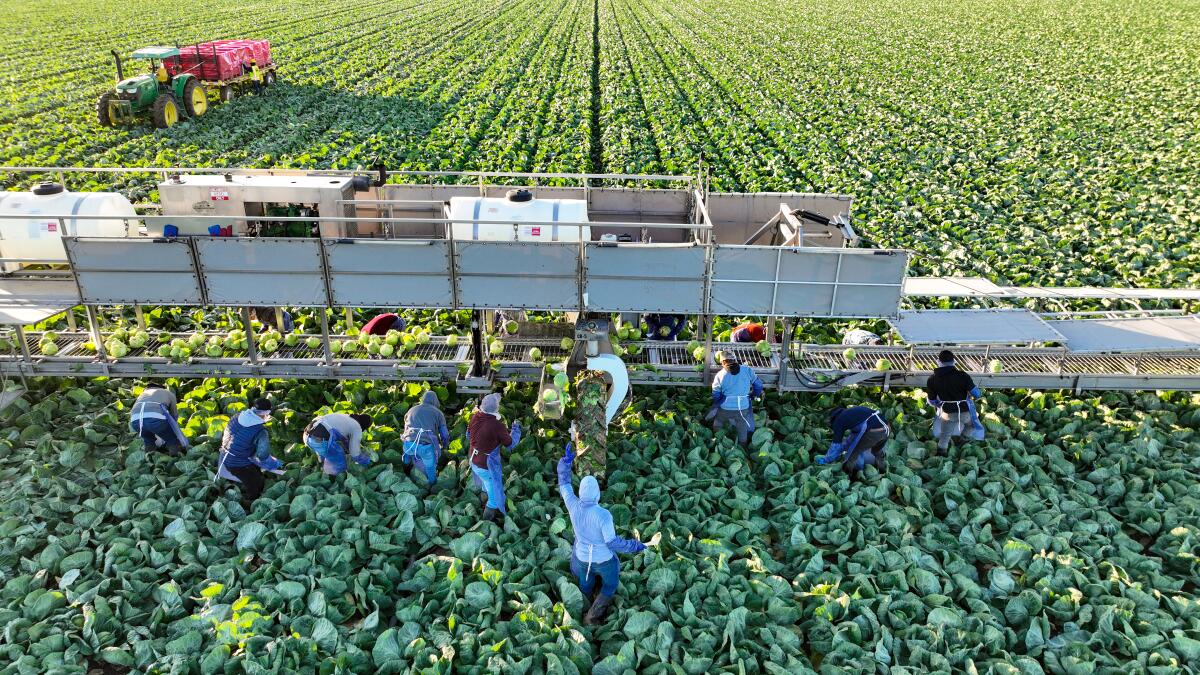
Imperial Valley farm barons use more Colorado River than anyone else in the West, at a time when lakes Mead and Powell, the nation’s largest reservoirs, are dangerously low. Imperial also has some of California’s most consistent sunshine, at a time when the state’s major cities need as much solar power as they can get to replace the fossil fuels heating the planet.
Does that mean the Imperial Valley has an obligation to use less water and generate more solar power? Or would farmers be within their rights to say: No, thank you, we want to keep things the way they are, no matter how much you pay us?
How you answer those questions will depend on your values, worries and life experiences.
But averting the worst consequences of the climate crisis won’t be painless for everyone, everywhere, all the time.
Solar farms, wind turbines and power lines will need to be built somewhere. Lithium for electric car batteries will need to be mined somewhere. And some communities and economies will be reshaped by renewable energy, with winners and losers.
Shedding light on those difficult transitions is the goal of our Repowering the West series. You can read it here.
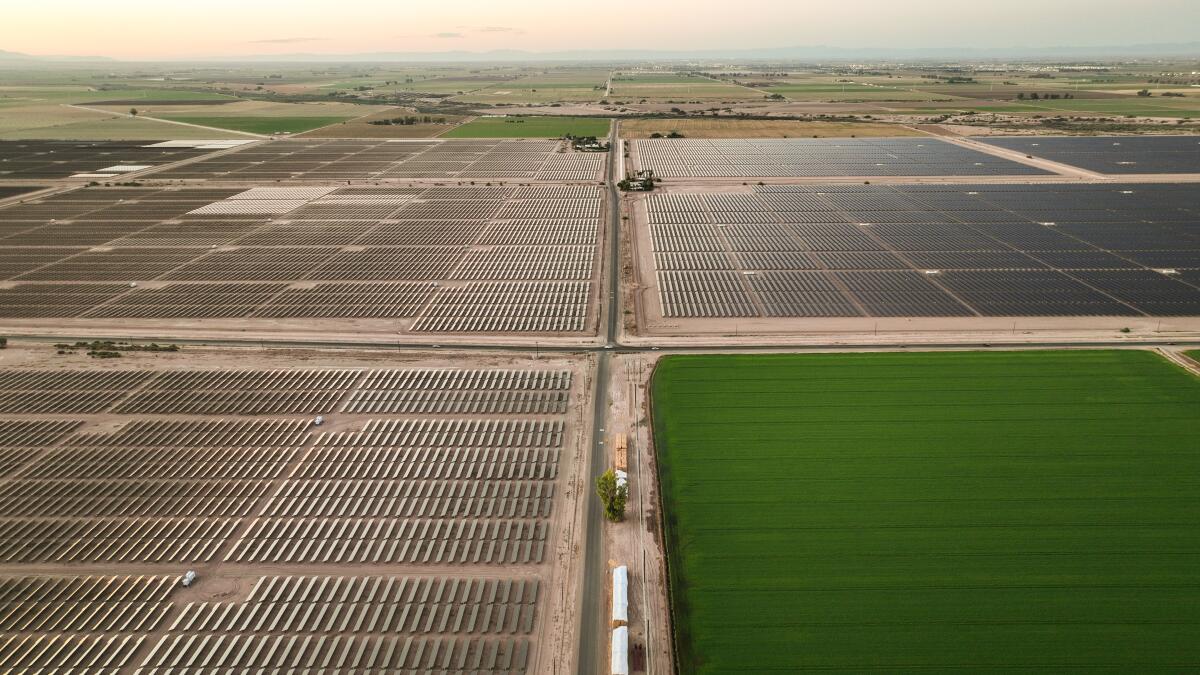
You may be wondering if we can avoid some of the tough sacrifices by putting solar panels on millions of rooftops in cities such as Los Angeles. The short answer is yes, probably. For Part 3 of Repowering the West, we’re traveling next week to Southern Nevada, to examine the trade-offs between large solar farms in the desert and smaller installations on rooftops.
At the same time, all the best research I’ve seen concludes that eliminating fossil fuels will be far cheaper and easier with both rooftop and large-scale solar. One way or another, the U.S. is going to have to build a lot of big infrastructure, fast.
All of which brings us back to the Imperial Valley, and Sen. Mark Kelly’s letter.
On the one hand, it’s Kelly’s job to be a fierce advocate for his constituents, Arizona’s 7 million residents. California uses a lot more Colorado River water than they do, and the Golden State hasn’t done enough to cut back. Imperial Valley landowners need to step up to the plate — and threatening funding for the Salton Sea creates political leverage over them.

So I sympathize with Kelly, to an extent. But so many of Imperial County’s 180,000 residents already endure so much — low wages, terrible air pollution, ever-hotter days working in the fields. And Kelly’s maneuver stood to make their lives worse.
That kind of politics just isn’t going to work. If Los Angeles, Phoenix and other Western cities want farm belts such as Imperial to supply them with water and clean power, they’ve got to treat those places like partners, not pieces on a chessboard.
It’s a moral imperative but also a practical one. The Imperial Irrigation District has good lawyers, as do many farmers. Water rights lawsuits have been known to drag on for decades. And there’s precious little time to save the Colorado River.
Clean energy development faces the same practical imperative. In every Western state, there are rural residents urging local officials to deny permits for solar farms, wind turbines and power lines they see as harmful to their communities. Those critics have won plenty of victories. Without some ability to forge consensus, the climate crisis will only get worse.

It’s unlikely that big cities and small towns will reach agreement on every energy project, water transfer or other conflict that emerge as the planet warms. But for any hope of a sustainable future, urban power brokers will need to engage in dialogue with their rural counterparts, to understand their challenges and needs and aspirations — and find ways to help.
At the same time, farmers and other rural community leaders will need to forge ahead with eyes wide open. The future won’t look like the past, whether they like it or not. Temperatures are rising. In the West, there’s less and less water to go around.
Change is scary. We’ve got no choice but to deal with it.
When the dust settled at the Salton Sea, President Biden’s appointees didn’t heed Kelly’s call. A few weeks after he sent his letter, the Interior Department announced $250 million in funding for the dying lake. Imperial Valley leaders breathed easier.
The money won’t solve all the valley’s problems. But it’s a first step.
One more time, here’s the link to my story on farm economies, solar power and water politics. You can reply to this email to let me know what you think. And if you want to support our continued climate journalism, buy a digital subscription.
And now, here’s what else is happening around the West:
AFTER THE STORMS

The worst of California’s torrential rainfall is over — and now we’re left to sort through the consequences. On the one hand, Sierra Nevada snowpack has reached “epic levels,” state officials say, providing a buffer against water shortages. Nearly every part of California is no longer suffering extreme or exceptional drought, the worst categories. And we should have lots of hydropower production this summer, limiting the need to generate electricity by burning natural gas, a fossil fuel. So that’s all good. On the other hand, the storms brought terrible destruction, for celebrities living in Montecito and also for residents of less fortunate communities. At least 20 people died, and swift water rescue teams risked their lives to save many more. If you’re having trouble making sense of it, The Times’ Deborah Netburn penned a beautiful spiritual reflection on rain, drought and climate change. “Rain has the ability to create, and to destroy. And so it becomes a matter of faith: We pray for it, even as we fear it,” she wrote.
The storms battered California’s fragile power grid — and as weather continues to get more extreme with climate change, patching up the grid won’t be enough. Experts say we’ll need more small-scale solar installations, batteries and microgrids to keep the lights on, my colleague Grace Toohey writes. We’ll also need to spend tens of billions of dollars widening river floodplains and otherwise protecting against catastrophic flooding in the Central Valley — which sounds like a lot until you consider the $1 trillion in potential damage from a destructive storm, The Times’ Ian James writes. For Californians already feeling the pain, Jon Healey and Karen Garcia explained what to do if your apartment flooded or a tree fell on your home, and how to find out if you’re eligible for a one-month extension on filing your tax returns. Even in a world without climate change, California’s political leaders would have their work cut out for them on flood management, Sacramento columnist George Skelton writes.
Even as we seesaw between drought and flood, let’s not lose track of the rising water along our coastline. Sea level rise is still a serious problem — and it gets worse when you factor in shallow groundwater being pushed up by ocean water, potentially causing damaging floods and toxic pollution. The Times’ Rosanna Xia wrote about crucial new research into this phenomenon. It’s focused on the Bay Area, but the same concerns exists up and down the California coast. “We live in nature and too often think of ourselves as separate from it,” one local official told Rosanna. “But nature is still very much in charge.”
POLITICAL CLIMATE
As conservative politicians rage against climate policies that encourage households to replace gas stoves with electric alternatives, here’s a key question: Does cooking with gas make you sick? My colleague Russ Mitchell cut through the political noise, writing that although there’s not yet conclusive science proving that gas stoves lead to health problems, there’s lots of research finding reasons to be worried. That research adds to the case for electrification — replacing planet-warming fossil fuels with electricity wherever possible. But as Grist’s Emily Pontecorvo writes, there’s a huge need for more electricians across the country. And in the short term, Californians are facing punishingly high natural gas prices, and thus larger-than-usual heating bills. The San Diego Union-Tribune’s Rob Nikolewski writes that state officials have pledged to examine why prices are so high.
Many of Exxon Mobil’s climate projections turned out to be more accurate than those by renowned NASA scientist James Hansen. Exxon made some of those projections at a time when the oil giant publicly denied the reality of human-caused climate change, even though its scientists clearly knew better, Tony Briscoe writes. The company’s climate denial played a role in delaying badly needed clean energy solutions for decades, fueling our current climate problems, as the L.A. Times helped reveal in a 2015 investigation. NASA’s latest numbers show that 2022 was tied for the fifth-hottest year on record globally. Or as The Times’ Corinne Purtill writes, “The planet hasn’t had a colder-than-average year since Gerald Ford was president.”
Long known for its political independence, Montana has taken a hard right turn toward Christian nationalism the last few years — a trend that threatens the state’s historically strong environmental protections. In a piece for the New York Times Magazine, Abe Streep writes that Montana’s ascendant far-right lawmakers have signaled their intent to revise an amendment in the state constitution, approved half a century ago, that guarantees “a clean and healthful environment” for residents.
AROUND THE WEST

The worst-case drought scenario has come to Rio Verde, Ariz. Homes have had their water shut off, with the neighboring city of Scottsdale saying it can no longer support the unincorporated desert community, the New York Times’ Jack Healy reports. “In a scramble to conserve, people are flushing their toilets with rainwater and lugging laundry to friends’ homes. They are eating off paper plates, skipping showers and fretting about whether they have staked their fates on what could become a desiccated ghost suburb,” Healy writes. For more on the broader Colorado River crisis, check out Part 2 of The Times’ ongoing podcast series, in which Ian James and Albert Brave Tiger Lee journey to the river’s headwaters. Albert also produced a video from their travels.
Bottlenose dolphins might fare better than some other sea creatures as the ocean heats up, if their migration to the Bay Area is anything to go by. In a hopeful bit of climate news, the San Francisco Chronicle’s Tara Duggan reports that these playful marine mammals have sought out new habitat as the waters off the Golden State warm, making the journey north from Southern California and Baja, Mexico. A new study documents 84 bottlenose dolphins in the Bay Area between 2007 and 2018.
New documents link Michigan’s largest energy company, DTE, to dark-money groups that worked to sabotage the state’s COVID-19 response. Here’s the story by the Guardian’s Tom Perkins. If you’re wondering why I’m including this in a newsletter about the West, it’s because of a story I wrote last year linking one of the same DTE-tied dark-money groups to carbon-capture research at California’s Lawrence Livermore National Laboratory. The company owns biomass plants in California that could benefit from state support for carbon capture — an idea opposed by activists who say the technology is highly polluting.
THE ENERGY TRANSITION
Orange County residents are increasingly concerned about electric bike safety, as e-bike riders on coastal boardwalks and elsewhere are involved in a growing number of collisions. Details here from The Times’ Hannah Fry. It’s fascinating to me to see all this hubbub over a climate-friendly transportation alternative when cars continue to be far more destructive. Just this week, Los Angeles officials reported that traffic deaths rose once again in 2022, with 312 people killed in collisions, Dakota Smith reports. We should definitely take e-bike safety seriously. But the dangers of driving are one of many reasons — including climate change — to shift our lifestyles and infrastructure away from automobile dominance wherever possible.
Los Angeles City Council again delayed a final vote on converting a gas-fired power plant to green hydrogen. Here’s the story from City News Service. Officials at the L.A. Department of Water and Power say hydrogen is needed to reach 100% clean energy by 2035, but some climate activists are skeptical. For background, see my story from last year on the fierce environmental justice debate over hydrogen. And see also this excellent breakdown by CalMatters’ Nadia Lopez of the challenges California must overcome to dramatically expand its power grid and supply millions of electric cars with climate-friendly energy.
The Biden administration intends to lend up to $700 million to a company planning to mine lithium in Nevada. As Canary Media’s Jeff St. John writes, the conditional loan for Ioneer Ltd.’s Rhyolite Ridge mine could help jump-start production of a metal crucial to electric car batteries and large-scale energy storage. But some conservation activists oppose the mining proposal, saying it could wipe out an endangered wildflower known as Tiehm’s buckwheat. This is a prime example of the tension between climate solutions and conservation — a tension I’m exploring through our ongoing Repowering the West series of stories.
ONE MORE THING

In a major victory for the nation’s largest gas utility, an appeals court ruled this month that Southern California Gas Co. doesn’t have to give state officials access to its internal accounting system — the latest twist in a consequential climate battle.
The California Public Utilities Commission’s ratepayer watchdog arm has been trying for several years to access SoCalGas’ internal accounting system. State officials say they need an inside look at the gas company’s finances to determine if it’s abusing customer money by, for instance, spending ratepayer dollars lobbying against climate change policies.
Mike Campbell, a program manager at the Public Advocates Office, told me in 2020 it would be difficult to trust that SoCalGas wasn’t hiding something incriminating because the company had previously provided misleading information about which of its activities were funded by ratepayers and which by shareholders — including anti-clean-energy initiatives.
“Frankly, how are you supposed to tell the difference if you don’t look at both?” Campbell asked.
A panel of judges disagreed. Or at least, it decided the gas company’s 1st Amendment rights were more important.
In a decision issued Jan. 6, California’s 2nd District Court of Appeal ruled in favor of SoCalGas, which had sued the Public Utilities Commission to block a subpoena. The court wrote that the Public Advocates Office can determine whether SoCalGas is abusing customer money without looking at how the company spends shareholder funds — funds it can use however it likes.
SoCalGas had argued that being forced to disclose how it spends shareholder funds would violate its rights to freedom of speech and freedom of association. The appeals court agreed, suggesting that a “less invasive discovery process” is crucial.
Climate advocates were not pleased. Sara Gersen — an attorney with the nonprofit law firm Earthjustice, which weighed into the legal dispute on the Sierra Club’s behalf — told me in an email that the court’s ruling would make it “that much more difficult to understand how SoCalGas undercuts climate action.”
SoCalGas didn’t respond to my request for comment, although the company has previously said it will “continue to be a partner in reaching California’s ambitious climate goals.”
Public Utilities Commission spokesperson Terrie Prosper wouldn’t tell me whether the agency plans to appeal the ruling, saying in an email that the commission “is reviewing the decision and its options.” She added that while the court concluded the agency’s data request was “not sufficiently narrow to withstand” the gas company’s free-speech argument, the court otherwise “rejected SoCalGas’ challenges to the [commission’s] process.”
The commission’s investigation into the gas utility’s expenditures is ongoing. More to come, as always.
We’ll be back in your inbox next week. If you enjoyed this newsletter, or previous editions, please consider forwarding it to your friends and colleagues. For more climate and environment news, follow me on Twitter @Sammy_Roth.
Toward a more sustainable California
Get Boiling Point, our newsletter exploring climate change, energy and the environment, and become part of the conversation — and the solution.
You may occasionally receive promotional content from the Los Angeles Times.

